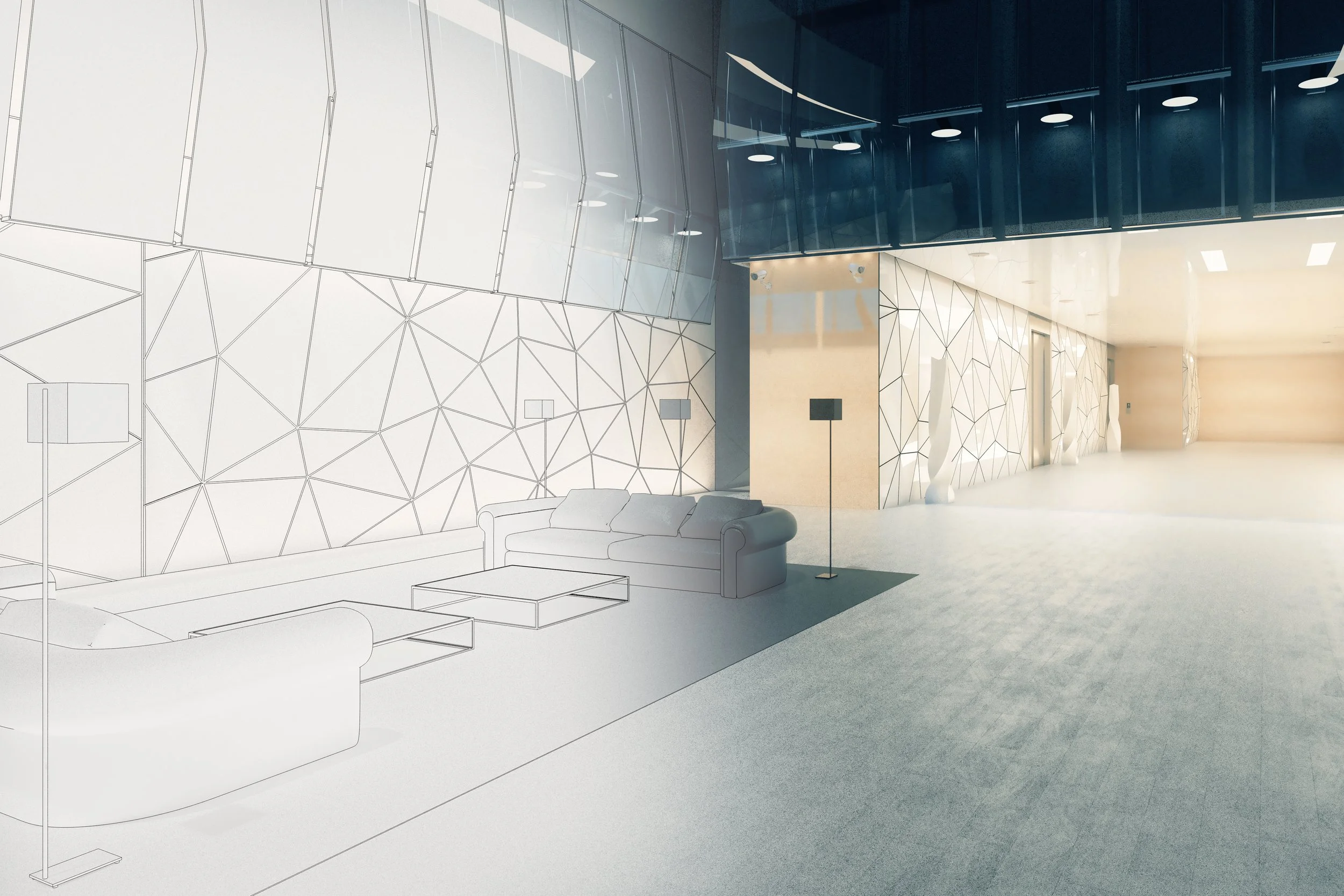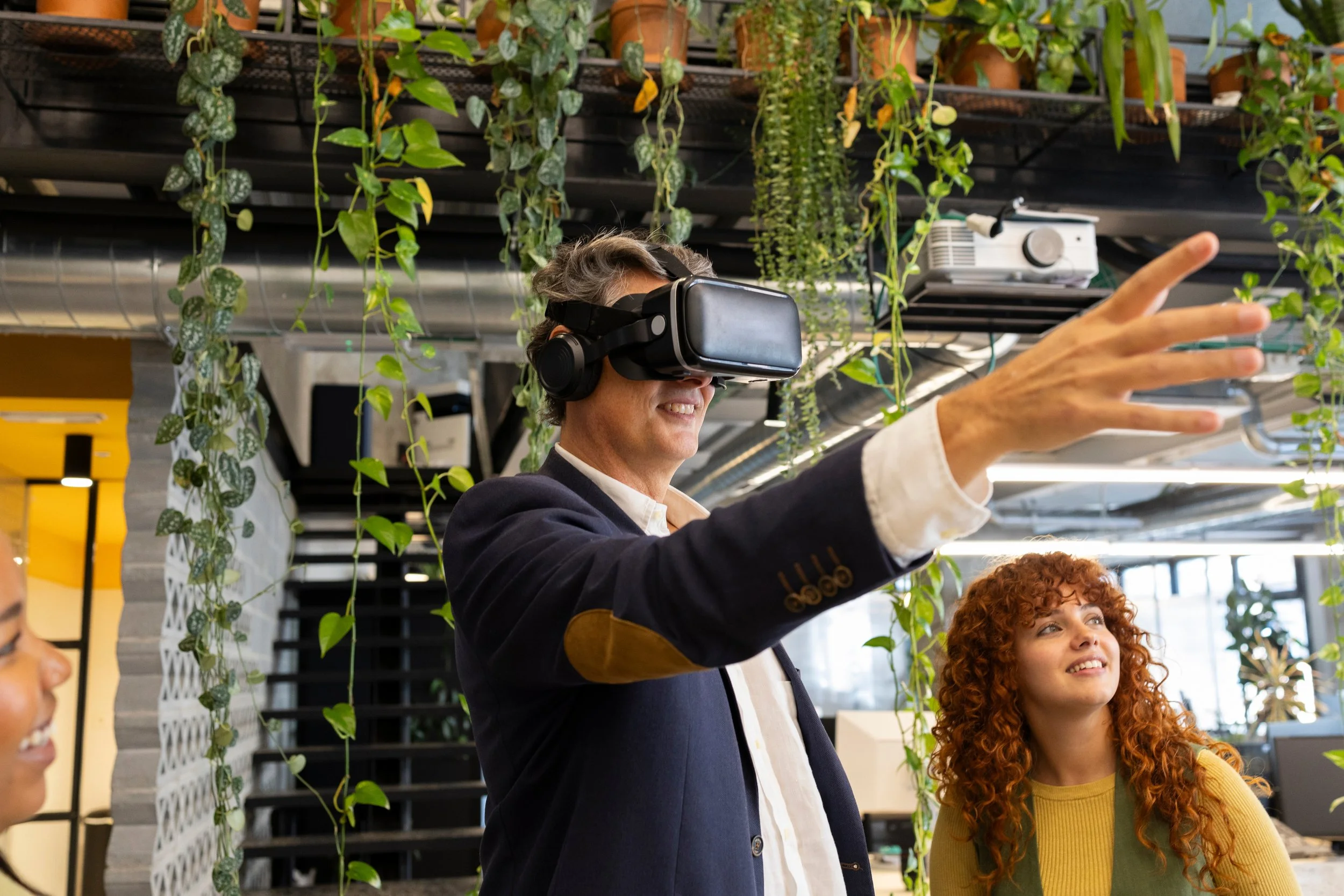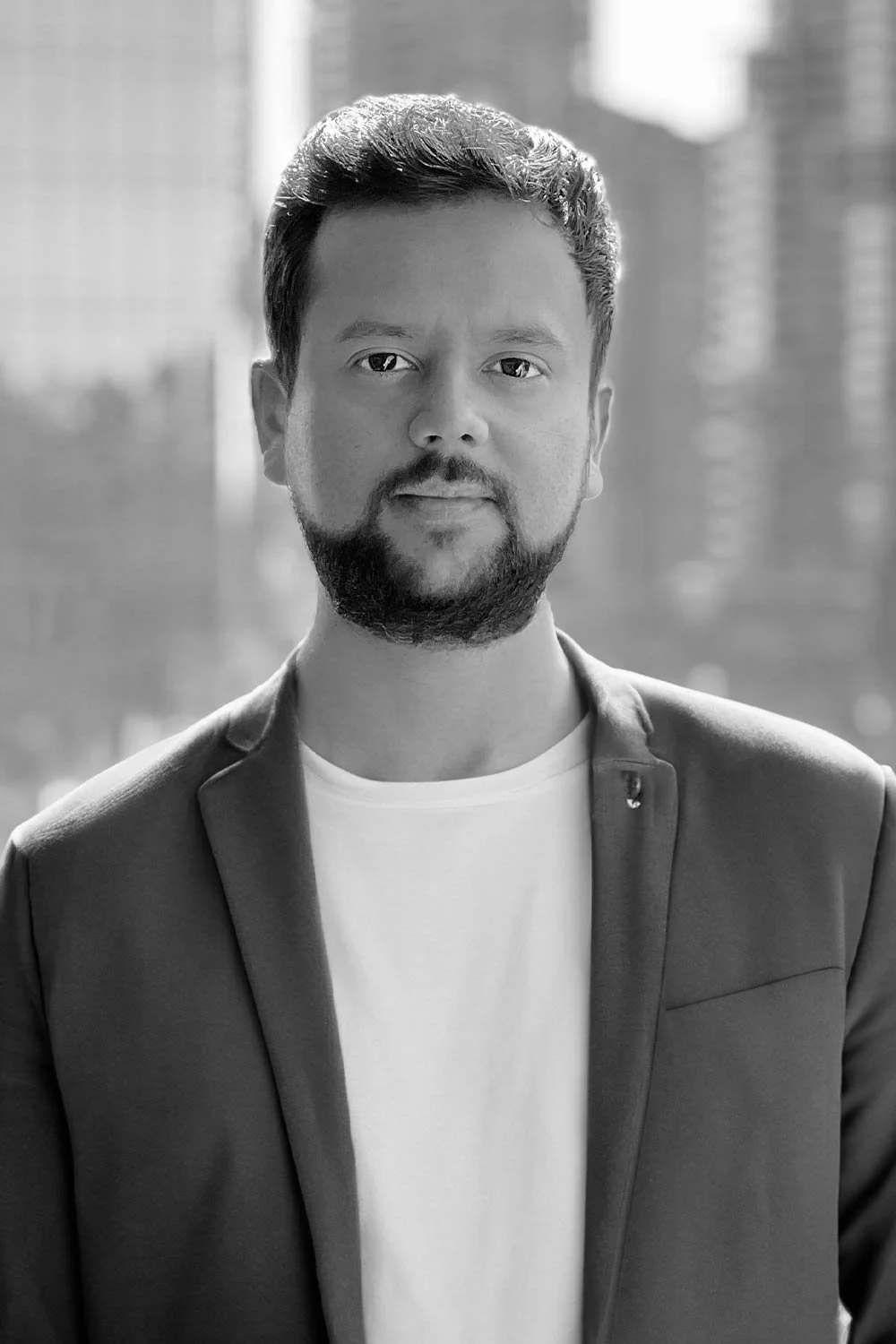
Corporate learning that matches where the region is heading: advanced tech, new industries, and teams who can think in 3D.

Participants learn by building together in UEFN — touching the same tools used across simulation, film production, and interactive media.

Teams can prototype ideas, test scenarios, and fail forward in controlled virtual worlds before committing to real-world change.

Sessions run in Warwick’s Fusion Esports Centre — a space built for experimentation, collaboration, and high-performance teams.

Masterclasses connect directly to Unreal Engine workflows — extending naturally into simulation, digital twins, and virtual production.

Not just a one-off workshop — a shift in how teams think, plan, and collaborate in a world where everything is interactive.
WHY THIS MODEL
The distance betweenindustry and academiashould feel small.
The UEFN Masterclass at Warwick Fusion Esports Centre — presented by the Centre for Entertainment Arts — brings together research culture, real-time technology, and practical production thinking. Teams learn through hands-on experimentation in an environment where academic insight connects directly to the demands of modern industry.
FUTURE SKILLS · IMMERSIVE TOOLS · INDUSTRY IMPACT











CEA Academic Partner Alumni Success.
What these masterclasses are
Masterclasses built around people and the next decade of tech evolution.
UEFN corporate masterclasses at Warwick Fusion Esports Centre are designed for teams who learn best by doing. Sessions use Unreal Editor for Fortnite to connect simulation, training, and future workflows to real corporate culture — replacing passive slides and webinars with shared, immersive experiences.
Hands-on with UEFN.
Sessions using Unreal Editor for Fortnite.
Participants learn how game engines power simulation, training, virtual production, and future workflows. No game development background required — these sessions introduce the tools shaping the next decade of work across manufacturing, automotive, enterprise teams, and creative technology.

Warwick × CEA.
Industry and academia together.
Delivered at Warwick Fusion Esports Centre and presented by the Centre for Entertainment Arts, these masterclasses combine research culture, hands-on production thinking, and real-time technology. The result is a training model that fits directly into the Midlands’ shift from pure industry to future-tech capability.

Powered by Unreal.
World-class real-time tech.
Training is built on Unreal Engine and UEFN — the same real-time engines used in advanced simulation, film production, automotive prototyping, virtual events, and next-generation training systems. Teams explore the tools that underpin the future of digital creativity and enterprise workflows.

Stay relevant.
Skills for the next decade.
Masterclasses give professionals a meaningful way to use PD and upskilling time — developing digital fluency, spatial reasoning, collaboration, systems thinking, and real-time problem-solving. Ideal for teams preparing for the Midlands’ new economy and the expectations of future clients, partners, and talent.

HOW THIS TRAINING IS DIFFERENT
A new model for teams.
UEFN masterclasses at Warwick Fusion Esports Centre move beyond conventional training. Instead of watching slides, teams step into shared, interactive environments where they make decisions together, test ideas safely, and develop new capabilities as a group.
Training model
Immersive
No one-way presentations — teams learn through hands-on scenarios, real-time decision-making, and collaborative interaction inside 3D spaces.
Delivery format
Flexible
Built to match your organisation’s rhythm — from short PD sessions to multi-day intensives, leadership offsites, or repeatable quarterly cycles.
Team outcomes
Dynamic
Designed for teams that need to adapt, collaborate, and solve problems together — building confidence, alignment, and shared capability.
INDUSTRY 01 · AUTOMOTIVE
Automotive. Digital twins for vehicles, systems, and experiences.
Automotive teams use Unreal for real-time design reviews, interactive configurators, and digital twins that help engineers evaluate form, aerodynamics, materials, and performance before a prototype is ever built.
From in-vehicle HMI to factory simulation, Unreal is becoming the core visualization layer for next-gen mobility.

INDUSTRY 02 · ARCHITECTURE
Architecture. Real-time spaces, materials, and light.
Architects rely on Unreal for immersive walkthroughs, daylight studies, and predictive space planning. Real-time rendering allows teams to iterate instantly — refining materials, lighting, and geometry with clients in the room.
Unreal reduces design cycles and elevates communication between architects, developers, and stakeholders.

INDUSTRY 03 · FILM & VP
Virtual Production. Cinematic worlds rendered live on set.
Film studios adopt Unreal for LED wall stages, previs, real-time environments, and digital cinematography workflows. Directors, DoPs, and VFX teams can visualize shots long before cameras roll.
Unreal enables faster iteration, reduced reshoots, and vastly more creative freedom.

INDUSTRY 04 · BROADCAST
Live Broadcast. Graphics, sets, and data-driven storytelling.
Broadcasters deploy Unreal for real-time graphics, augmented reality sets, and interactive data layers that transform sports, esports, and news production.
Unreal’s real-time pipeline allows creative teams to refresh visuals instantly and keep pace with live events.

INDUSTRY 05 · TRAINING & SIMULATION
Simulation. Safe sandboxes for high-stakes learning.
Engineering, defence, aviation, and manufacturing teams use Unreal for virtual training, procedural simulation, and scenario planning — all built on accurate physics and real-time feedback.
Simulations enhance preparation, reduce real-world risk, and provide measurable performance data.

INDUSTRY 06 · MEDICAL
Medical Visualization. Human systems made interactive.
Medical organizations use Unreal for surgical simulation, patient education, anatomy visualization, and procedural training powered by real-time 3D accuracy.
Unreal improves understanding, supports clinical learning, and brings clarity to complex medical concepts.

Elevate
The Professional.
Innovate
The Method.
Empower
The Future.
CEA Academic Partner
The people behind the process.
The Centre for Entertainment Arts Academic Partner team combines production experience, pedagogy, and technology. These are the people who design the processes, critiques, and routines that help students think, make, and behave like working professionals.
Academic Leadership
Michael Bradbury
Director of Education
With a BSc Hons in Game Design, PGCE, NPQSL, MA in Education, and a PhD in progress in Digital Transformational Education, Michael is a specialist in gaming education and curriculum design. As the first Unreal Authorized Instructor in the UAE, he plays a pivotal role in Dubai’s emerging games ecosystem, collaborating with industry and government to deliver advanced Unreal Engine training. Michael focuses on building robust curriculum structures and supplemental content libraries that empower instructors, sharpen pedagogy, and keep academic quality tightly aligned to industry needs.
Michael is a specialist in gaming education and curriculum design with degrees in game design and education, and a PhD in progress in Digital Transformational Education. As the first Unreal Authorized Instructor in the UAE, he links industry, government, and academia while building curriculum and content libraries that keep teaching tightly aligned to real production needs.

Innovation & Technology
Jamie McClenaghan
Director of Innovation and Technology
Jamie is a game developer, educator, and tech innovator with a Computer Science degree from the University of Cambridge. A well-being app he built during the pandemic quickly gained traction in schools, cementing his reputation as a practical problem-solver. He now connects creative technologists across Europe and the Middle East, using games and interactive experiences as tools for transformation. Guided by empathy and resilience, Jamie treats curiosity and iteration as core professional skills, showing students how bold ideas and disciplined execution can drive real change.
Jamie is a game developer, educator, and tech innovator with a Computer Science degree from the University of Cambridge. After his well-being app gained traction in schools, he began linking creative technologists across Europe and the Middle East, using games and interactive experiences to drive change. He teaches students to pair bold ideas with disciplined iteration.

VFX & 3D
Priyank Murarka
Director of VFX & 3D Programs
Priyank leads CEA’s Visual Effects and 3D programs, drawing on more than a decade of experience as both a VFX artist and senior production leader. He designs curricula that fuse technical rigor with creative storytelling, preparing students for real roles on film, series, and cinematic projects. Priyank reinforces industry readiness through guest workshops, exposure to current tools and workflows, and deliberate career mentoring — helping students understand how to build portfolios that speak the language of modern VFX and 3D pipelines.
Priyank leads CEA’s Visual Effects and 3D programs, drawing on over a decade as both VFX artist and production leader. He designs curricula that fuse technical rigor with storytelling and uses guest workshops, current tools, and focused mentoring to help students build portfolios that speak studio language.

Animation
Jon-Jon Atienza
Director of Animation Programs
Jon-Jon is an animation and FX artist whose credits include award-winning shorts such as “Skin for Skin” and the Oscar-nominated National Film Board short “The Flying Sailor.” After more than a decade with Fifteen Pound Pink Productions, he now teaches full-time at Bow Valley College’s Centre for Entertainment Arts. Jon-Jon emphasizes character, form, and performance, helping students understand how subtle choices in motion and design can bring animated work to life — and how to carry that craft into both independent and commercial production environments.
Jon-Jon is an animation and FX artist whose work includes “Skin for Skin” and the Oscar-nominated NFB short “The Flying Sailor.” After more than a decade at Fifteen Pound Pink Productions, he now teaches full-time, focusing on character, form, and performance to help students bring animated work to life.

Film
Subhadarshi Tripathy
Director of Film Programs
Subhadarshi is a media and entertainment executive with more than 20 years of experience building global content platforms. His track record spans trend analysis, collaboration with high-calibre production teams, and delivering shows and formats that travel. He has received the Prix Jeunesse and the Asian Television Awards’ Best Talk Show Award, and served as lead animator on India’s first animated feature. His short film “Another Reminder” screened at Hiroshima and Mumbai International Film Festivals. In the classroom, he turns that experience into guidance on story, audience, and long-term creative careers.
Subhadarshi is a media and entertainment executive with over 20 years of experience building global content platforms. Awarded the Prix Jeunesse and Asian Television Awards’ Best Talk Show Award, and lead animator on India’s first animated feature, he now channels that experience into teaching story, audience, and long-term creative careers.

Games
Sean Lynch
Director of Game Programs
Sean is the Director of Games Programs at CEA, with a Master’s in Computational Media Design that bridges computer science and fine arts. A lifelong gamer, he has taught programming, game design, and educational games, and has designed escape-room experiences. Sean is a published author in information visualization, human–computer interaction, and computational music. He leads students into alternative interfaces and experimental play, treating game technology as a language that will shape future communication, interaction, and how people experience complex systems.
Sean is Director of Games Programs at CEA, with a Master’s in Computational Media Design bridging computer science and fine arts. A lifelong gamer, he has taught programming and game design, designed escape rooms, and published research in HCI and visualization, guiding students into experimental interfaces and future-focused game technology.

Esports
Gary Tibbitt
Director of Esports Programs
Gary has more than a decade of experience in video games and esports, and helped develop the world’s first accredited esports qualification. As Director of Esports Programs at CEA, he builds partnerships across institutions and industry, working with companies like Riot Games, Tencent, Microsoft, and Dell. Gary treats esports as a training ground for cognitive skills, teamwork, and community-building, showing students how broadcast, competition, and content can unlock inclusive, global opportunities in a fast-scaling sector.
Gary has over a decade in video games and esports and helped develop the world’s first accredited esports qualification. At CEA he links institutions and major partners like Riot, Tencent, and Microsoft, treating esports as a space to build cognitive skills, teamwork, and global career opportunities.

Stay relevant in a hyper-evolving tech era.
This isn’t just about learning a new tool. It’s a deliberate reset of how you work — using Unreal, real-time 3D, and AI to rewire habits, reframe problems, and build workflows that actually match the pace of change.
Professionals who treat this moment as a one-time upgrade get left behind. Those who treat it as an ongoing transformation build a different kind of advantage: fluency with tools, confidence with AI, and a personal operating system that can keep evolving.
PROFESSIONALS · TRANSFORMATION MINDSET
Stage 01
Awareness · The pace of change
Understand the true speed of technological acceleration — and why static, legacy workflows create blind spots that compound over time for even the most experienced professionals.
Stage 02
Context · Beyond “just gaming”
See how real-time 3D, simulation, and AI are already reshaping sectors like automotive, architecture, training, and medical — not as hype, but as concrete operational tools.
Stage 03
Mindset · From static to systems
Shift from slide decks and static documents to spatial, interactive, and systems-based thinking — the mental model required for hybrid human–AI workflows.
Stage 04
Entry · Safe hands-on onboarding
Get comfortable in Unreal environments through guided, low-pressure challenges that build confidence quickly, even if you’ve never touched a game engine before.
Stage 05
Experiment · Explore without risk
Use a structured sandbox to test ideas, fail safely, and iterate fast — discovering new possibilities through play instead of high-stakes, live projects.
Stage 06
Integrate · Meet your real workflows
Start attaching Unreal, AI copilots, and real-time visualisation tools to the processes you already use — meetings, planning, reviews, and client communication.
Stage 07
Collaborate · Shared virtual context
Work in shared virtual spaces where assets, ideas, and decisions are visible to everyone — compressing slow, fragmented feedback loops into live, collective problem-solving.
Stage 08
Merge · One continuous pipeline
Link real-time engines, AI, and traditional tools into a single creation pipeline — so work flows, updates, and approvals move at the speed of the system, not inboxes.
Stage 09
Accelerate · Remove friction
Identify repetitive, low-value steps and either streamline or automate them — freeing time and attention for higher-order problem-solving and leadership.
Stage 10
Advance · AI as a creative partner
Use AI for prototyping, briefing, simulation, and creative exploration — not as a gimmick, but as a disciplined extension of your own judgment and taste.
Stage 11
Influence · Lead others through change
Learn how to bring teams, clients, and stakeholders with you — using clarity, visualization, and rapid prototyping to de-risk bold decisions.
Stage 12
Fluency · A living operating system
Leave with a flexible, evolving personal operating system — one that can absorb the next generation of tools, platforms, and opportunities without starting from zero.
Frequently asked questions
Questions professionals ask about this shift.
The Warwick · CEA · Unreal Engine pathway is built for people who want to stay relevant in a world of 3D, real-time, simulation, and AI — without walking away from their current careers. These are the questions that come up most often.
Is this right for my role and background?
Short answer
Yes — if you feel the pace of technology out-running your current toolkit and you’re ready to lean into 3D, real-time, and AI as part of your practice.
Long answer
The program is designed for professionals across sectors — design, media, education, architecture, automotive, strategy, innovation, product, and beyond — who need to understand and use real-time 3D, simulation, and human–machine interfaces as part of how they lead and deliver work. You do not need to be a programmer or game developer. You do need curiosity, a willingness to experiment, and a desire to translate these tools into your own context.
Things to think about
- This is not about changing who you are — it is about extending what you can do.
- Your existing domain knowledge becomes an asset once you can express it in 3D and real-time.
- If you already feel the gap between your ideas and your tools, you’re in the right place.
INVEST IN YOUR REAL-TIME FUTURE
EXPLORE THE WARWICK · CEA · UNREAL PATHWAY →